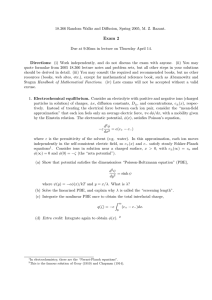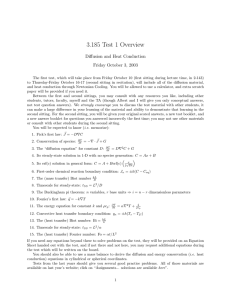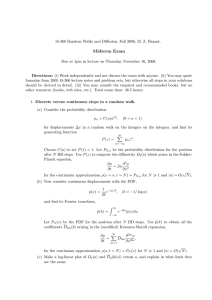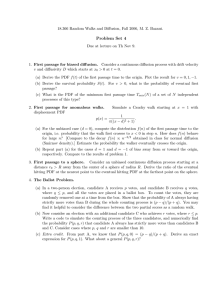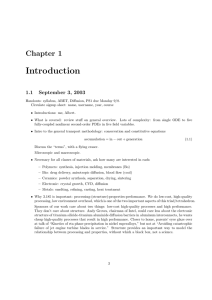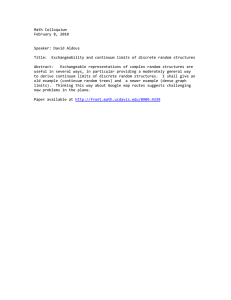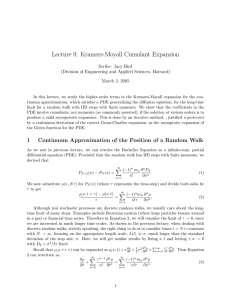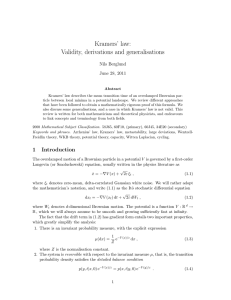Lecture 8: The Continuum Limit
advertisement
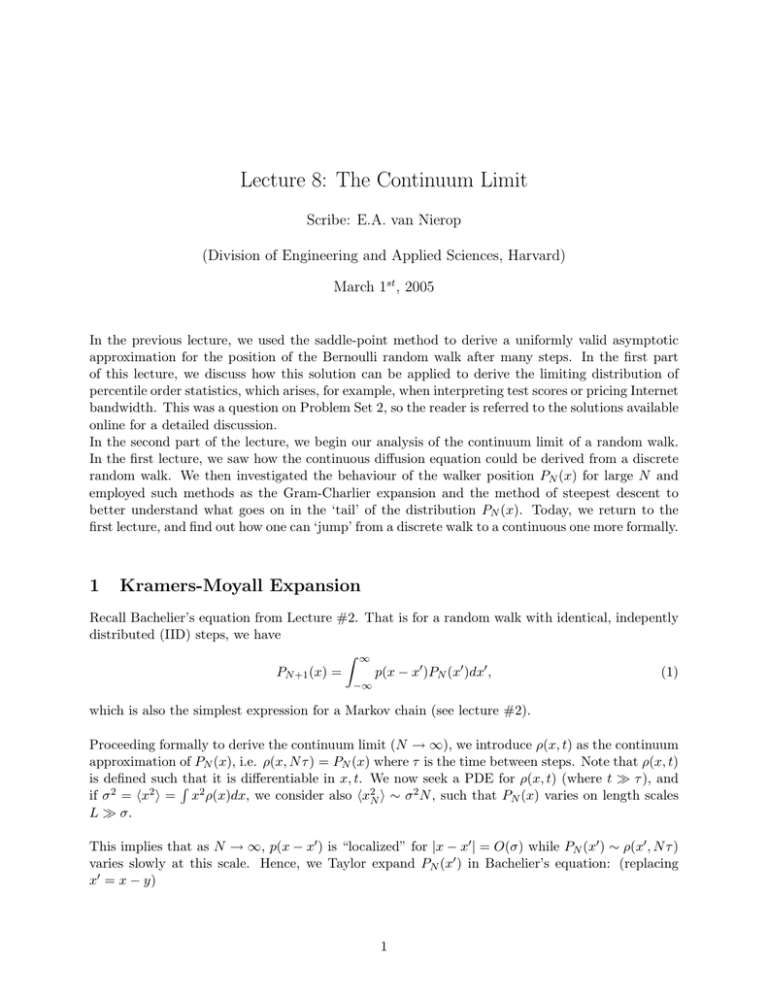
Lecture 8: The Continuum Limit Scribe: E.A. van Nierop (Division of Engineering and Applied Sciences, Harvard) March 1st , 2005 In the previous lecture, we used the saddle­point method to derive a uniformly valid asymptotic approximation for the position of the Bernoulli random walk after many steps. In the first part of this lecture, we discuss how this solution can be applied to derive the limiting distribution of percentile order statistics, which arises, for example, when interpreting test scores or pricing Internet bandwidth. This was a question on Problem Set 2, so the reader is referred to the solutions available online for a detailed discussion. In the second part of the lecture, we begin our analysis of the continuum limit of a random walk. In the first lecture, we saw how the continuous diffusion equation could be derived from a discrete random walk. We then investigated the behaviour of the walker position PN (x) for large N and employed such methods as the Gram­Charlier expansion and the method of steepest descent to better understand what goes on in the ‘tail’ of the distribution PN (x). Today, we return to the first lecture, and find out how one can ‘jump’ from a discrete walk to a continuous one more formally. 1 Kramers­Moyall Expansion Recall Bachelier’s equation from Lecture #2. That is for a random walk with identical, indepently distributed (IID) steps, we have � ∞ PN +1 (x) = p(x − x� )PN (x� )dx� , (1) −∞ which is also the simplest expression for a Markov chain (see lecture #2). Proceeding formally to derive the continuum limit (N → ∞), we introduce ρ(x, t) as the continuum approximation of PN (x), i.e. ρ(x, N τ ) = PN (x) where τ is the time between steps. Note that ρ(x, t) is defined such �that it is differentiable in x, t. We now seek a PDE for ρ(x, t) (where t � τ ), and 2 � ∼ σ 2 N , such that P (x) varies on length scales if σ 2 = �x2 � = x2 ρ(x)dx, we consider also �xN N L � σ. This implies that as N → ∞, p(x − x� ) is “localized” for |x − x� | = O(σ) while PN (x� ) ∼ ρ(x� , N τ ) varies slowly at this scale. Hence, we Taylor expand PN (x� ) in Bachelier’s equation: (replacing x� = x − y) 1 M. Z. Bazant 18.366 Random Walks and Diffusion � Lecture #8 2 ∞ p(y)PN (x − y)dy, PN +1 (x) = −∞ � ∞ = p(y) n=0 ∞ n � (−1) n=0 mn n! n=1 dxn n! , dn PN (x) , dxn ∞ � (−1)n = PN (x) + (2) ∞ � (−y)n dn PN (x) −∞ = Spring 2005 n! mn dn PN (x) , dxn (3) (4) (5) � where the moments, mn , are defined as usual (mn = xn p(x)dx) and they are assumed to exist. Note that in the last step we use m0 = 1 which is always true. Bringing PN (x) to the other side and dividing by τ gives ∞ dn PN (x) PN +1 (x) − PN (x) � = (−1)n Dn , τ dxn (6) n=1 n where Dn = m n!τ . Note that the left­hand­side now strongly resembles a time derivative of PN (x). Following through with that thought, and introducing ρ(x, t) into the equations we get: ∂ρ ∂t ≈ ∞ � (−1)n Dn n=1 = −D1 ∂nρ ∂xn ∂3ρ ∂ρ ∂2ρ + D2 2 − D3 3 + . . . ∂x ∂x ∂x (7) (8) Often, as in Risken’s recommended book The Fokker­Planck Equation, Equation (8) is referred to as “Kramers­Moyall” expansion. However, this should not strictly be interpreted as an asymptotic expansion, since errors are introduced by the first­order continuous time derivative on the left hand side. Note that no terms have been ‘thrown away’ on the right hand side, yet all higher­order time derivatives on the left have disappeared. Also, we should have known something fishy was going on since eq.(8) uses the moments rather than the cumulants which we know from earlier lectures to be the more important parameters. As we shall see, this form of the Kramers­Moyall expansion is really only valid at leading order in the limit of infinitessimal steps (discussed below and by Risken), where only the first two terms survive, ∂ρ ∂ρ ∂2ρ + D1 = D2 2 (9) ∂t ∂x ∂x which is a linear advection­diffusion equation, the simplest case of the “Fokker­Planck equation” (discussed later in the class). 2 Continuum Derivation of the Central Limit Theorem We will now systematically correct the Kramers­Moyall expansion and study the scaling of its terms. We will focus on the long­time (or many step, N � 1) limit, where we will see that the PDF M. Z. Bazant Spring 2005 18.366 Random Walks and Diffusion Lecture #8 3 spreads out and varies slowly in time. Thus, we consider Taylor expansion of the smooth continuum interpolant, ρ(x, t), satisfying PN (x) = ρ(x, N τ ), around t = N τ : ∂ρ τ ∂ 2 ρ τ 2 ∂ 3 ρ PN +1 (x) − PN (x) = + + + ... τ ∂t 2 ∂t2 3! ∂t3 (10) Combining this with eq.(8) yields a modified expansion with high order derivatives in both time and space: ∞ ∞ ∂ρ � ∂ n ρ τ n−1 � ∂nρ n + = (−1) D (11) n ∂t ∂tn n! ∂xn n=2 n=1 This is the complete (formal) partial differential equation (PDE) equivalent to Bachelier’s equation. Scaling analysis: To obtain and accurate asymptotic approximation for the limit N → ∞, we non­dimensionalize our variables by choosing a some typical length­scale L, which will be self­ consistently (and uniquely) defined later in the analysis. Thus, we define x̃ = x/L, T = N τ and t̃ = t/T , and ρ̃ = ρ/L and obtain dimensionless PDE: ∞ 1 ∂ ρ̃ � 1 τ n−1 ∂ n ρ̃ + T n n! ∂ t̃n T ∂ t̃ n=2 ∼ ∞ � n=1 ∞ 1 ∂ ρ̃ � ∂ n ρ̃ + ∂ t̃ n=2 N n−1 n! ∂ t̃n (−1)n Dn ∂ n ρ̃ Ln ∂ x̃n (12) ∼ − D1 N τ ∂ ρ̃ D2 N τ ∂ 2 ρ̃ D3 N τ ∂ 3 ρ̃ + − + ... L2 ∂ x̃2 L3 ∂ x̃3 L ∂ x̃ (13) = − m1 N ∂ ρ̃ m2 N ∂ 2 ρ̃ m3 N ∂ 3 ρ̃ + − + ... 2L2 ∂ x̃2 3!L3 ∂ x̃3 L ∂ x̃ (14) (15) Now, we re­scale x to accommodate the ‘drift’ of the random walker using z˜ = x ˜− ˜ ˜ m1 N/L is the drift velocity. We also define ρ(˜ ˜ x, t) = φ(˜ z, t), so that ∂ρ̃ ∂t̃ ∂2φ ∂t̃2 = = = ∂ n ρ̃ ∂x ˜n = m1 N L t̃, ∂φ ∂φ ∂z̃ ∂φ m1 N ∂φ + = − ∂z̃ ∂t̃ L ∂z̃ ∂t̃ ∂t̃ ∂ 2 φ ∂z̃ ∂ 2 φ ∂z̃ 2 ∂2φ +2 + 2( ) ∂z̃ ∂t̃ ∂t̃2 ∂ z̃∂t̃ ∂t̃ ∂2φ m1 N ∂ 2 φ m1 N 2 ∂ 2 φ − 2 + ( ) L ∂ z∂t̃ L ∂z̃ 2 ∂t̃2 ˜ n ∂ φ . ∂z̃ n where (16) (17) (18) (19) (20) Hence, the modified Kramers­Moyall expansion becomes: ∂φ m1 N ∂φ � 1 ∂ 2 φ m1 ∂ 2 φ − + − ˜ L ∂ t∂z̃ 2N ∂t̃2 L ∂z̃ ∂t̃ + − m21 N 2L2 m1 N L � ∂2φ � � 1 ∂3φ + . . . + ... = + ∂z̃ 2 3!N 2 ∂t̃3 ∂φ m2 N ∂ 2 φ m3 N ∂ 3 φ + − + ... ∂z̃ 2L2 ∂z̃ 2 3!L3 ∂z̃ 3 (21) Note that in this equation the first derivative ∂φ/∂z̃ drops out which of course was the entire point of introducing z. ˜ Remember that a proper choice for L will ensure that φ(˜ z) exists, does not blow M. Z. Bazant 18.366 Random Walks and Diffusion Spring 2005 Lecture #8 4 up as N → ∞ and integrates to 1. We now consider a dominant balance of eq.(21) noting that the first term on the left hand side must be included since φ is known to evolve in time. It is then consistent to keep terms of order N/L2 on the right hand side. To demonstrate this, consider what would happen if we decided to make the dominant balance with terms of order N/L3 . . . such that L ∼ N 1/3 and terms of order N/L2 ∼ N 1/3 which blows up as N → ∞. Thus, we are led to the first­order approximation as N → ∞ and with z˜ = O(1): ∂φ (m2 − m21 )N ∂ 2 φ 1 ∂2φ ∼ ≡ . (22) ∂z̃ 2 2 ∂z̃ 2 2L2 ∂t̃ √ So we are naturally led to choose L = σ N where σ 2 = m2 − m21 is the variance as usual / expected. Specifically, L does not depend on m2 which the unmodified Kramers­Moyall expansion claims. This is essentially a continuum proof of the Central Limit Theorem. After all, we know how to solve the diffusion equation given an initial peak distribution φ(˜ z, 0) = δ(˜ z), namely ˜ = φ(˜ z, t) PN (x) = √ √ 1 z ˜2 e− 2t̃ 2πt̃ 1 2πσ 2 N e− (23) (x−m1 N )2 2σ 2 N , (24) where the scaling has been put back into the final expression for PN (x) and t̃ = 1, i.e. we are ‘in’ the central region. A note on the validity of the continuum limit . . . continuum diffusion implies that there is a finite (albeit very small) probability of finding the random walker at some enormous distance from its’ starting point for any time t = 0 + �. In the next lecture, we will show that the higher­order terms in the PDE of the modified Kramers­ Moyall expansion reproduce the Gram­Charlier expansion of the discrete PDF at all orders, showing that the continuum limit provides a systematic approximation of the “central region”.
